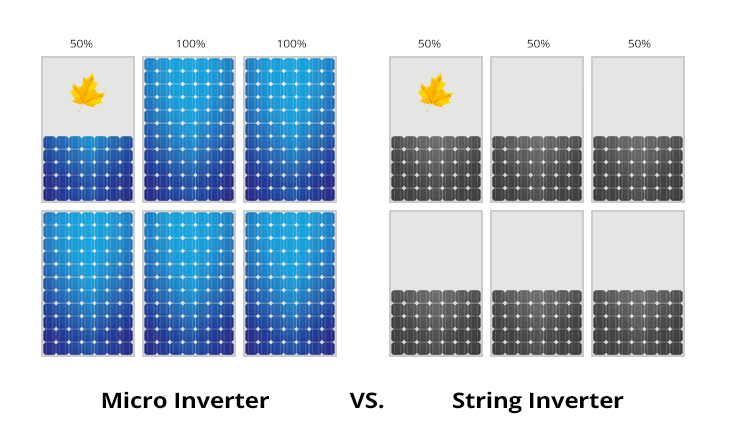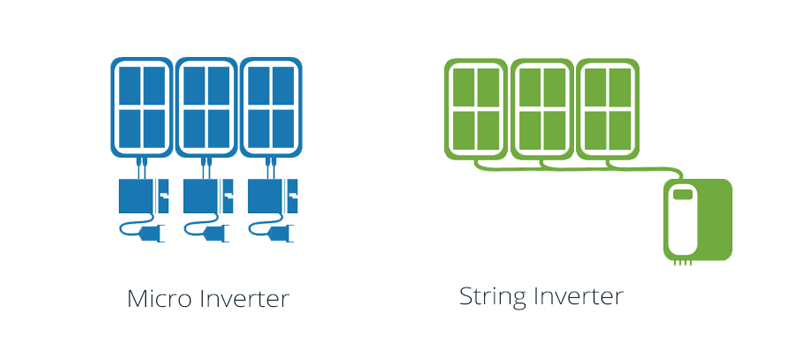Home Do Solar Panels Work in the Shade?
Do solar panels work in the shade?
It’s common knowledge that solar panels<\/a> require plenty of sunlight to generate electricity. However, what’s the go when your roof is often under the shade or only receives occasional sunlight?
Solar panels do not work in the shade. If it is partial shade, you can install the right system (micro-inverters) to mitigate the problem. With a string inverter, however, the whole array is knocked out with just a partly shaded panel.
To understand this, let’s dive deeper into solar panel sunlight requirements, and how shading affects it.

Table of Contents
ToggleSolar panels in partial shade – Why it’s so bad
With solar panels, shading of any magnitude, even on a small part of the cell or a module, drastically impacts its output. Here’s why.
Solar panels are devices comprised of strings of photovoltaic cells. We can use the water pipe analogy to make understanding electricity production easier. Assuming you have a water pipe, if one part of the pipe clogs or blocks, the entire water supply is disrupted.
Similarly, each cell and module of the solar panel works like this pipe or circuit.
The current produced becomes our water flowing through the solar cells and shade is the clog in our pipe.
If one cell or module of the panels is shaded, the current movement between the panel slows down. What’s worse, for some panels brands, partial shading on even one cell on the panel may result in a complete halt in electricity production.

How to combat partial shade with inverters
Inverters are the brains of your entire solar system. They convert the direct current DC from the panels into the usable alternating current AC for your home and appliances. There are three main types of inverters in the market, i.e., string inverters, microinverters (AC solar panels), and power optimizers.

String inverters (bad for partial shade)
Each of these panels works differently. The string inverter is the most popular and only really works infill the sun. A string inverter system works under the concept that your solar panels are only as effective as your weakest panel.
Here, all solar panels are connected to one central inverter. Therefore, shading on one panel affects the efficiency of every panel in the system.
Microinverters (Good for partial shade)
Microinverters, on the other hand, assigns each solar panel to its own inverter. This way, if one panel is shaded, the efficiency of the remaining panels isn’t affected.
As you probably now know, the microinverters are your best bet at combating partial shading. They might be more expensive than string inverters, but their output is better and offer better savings long-term.
Solar optimizers (Good for partial shade)
Solar panel power optimizers are halfway between a sting and microinverter, and an also great alternative. Like microinverters, each solar module is assigned its individual DC optimizer. However, the difference comes in the output as the optimizers direct all the produced DC to one string inverter.
This way, each solar module works independently, ensuring that shading in one module doesn’t affect the overall output of electricity generated.
Tip: Ensure that the inverter you choose has Maximum Power Point Tracking(MPPT) capabilities. This will enable it to maximize the power available from the solar panels under any condition.
Other problems with partial shading
Partial shading may also result in early solar panel failure due to overheating.
This is because when shading occurs, some cells work harder than others to cover the shaded cells and this reduces the overall lifespan of the panels.
Solar panel efficiency in the shade
There are several factors to consider when looking at efficiency drops due to shade.
- What time of day does the shading occur?
- Does that shade cover the entire solar array?
- Do you have micro-inverters?
- How long is the array shaded?
- How much of the array is shaded?
There are too many variables to give you an exact figure, but it’s safe to say that if you are running a system with a microinverter and you have 50% shade at 8 am for 1hour, then your loss will be minimal as panels are not producing much power at this time.
If however, the shading occurs at 12 noon, for 1 hour and covers 50% of your array, you would lose 10% of the days/months overall energy production.
How much sunlight do solar panels need?
The simple answer is the more the better. Basically, the higher in the sky the sun is, and the number of hours the sun out, directly correlates with the energy production of your solar system.
Peak hours refer to the hours when your solar radiation is highest allowing solar panels generate the most electricity.
On average, your panels should have at least four hours of peak sun hours to generate enough electricity for your home. However, peak hours vary depending on your location in Australia and the weather conditions.
The most common sources of shade include:
Trees – In most cases, shading comes from the trees close to your panels. With most homes embracing green spaces, the tree branches and leaves may slowly encroach above your solar panels blocking the sun rays from reaching the panels.
Buildings and walls – Neighboring buildings and walls may also cast some shade on your panels, hindering their access to sunlight. Your roof design may also cause some shade on your panels if incorrectly installed.
Other panels – If your solar panels are on the ground, other panels may also be the reason for the partial shadowing. This may be due to poor installation leaving some panels to cast shade on the others.
Clouds – While clouds don’t completely block out the sunlight, cloudy weather reduces the sunlight penetration during peak hours, affecting the overall solar output.
Chimminy – “Why’s it there? Charm, adds a bit of charm.” Like Daryl home from The Castle Most chimney’s serve no real purpose and can shade solar panels.
TV antenna – Even though the shadow is thin, it is enough to knock out an entire system. You may need to consider moving this when panels are installed.
Ways you can reduce shading
There are several things you can do to reduce the shading on your solar panels. The first way would be moving your panels to a more open and more transparent space, if possible. This will be ideal if you’ve not yet finalized the installation process.
If this isn’t possible, here are a few things you should try:
Remove the shade-causing trees
Trees, whether close or far from your panels, could be the reason for your solar panels’ low efficiency. So, trim or remove the tree to create a clear way for direct sunshine.
Watch out also for the size of trees you plant around the house. Since your solar panels can last up to 30 years, these trees shouldn’t grow to cause shading problems in the future.
Use a bypass diode
If you’re using a string inverter system, then consider using a bypass diode to mitigate the effect of shading on one PV cell. The bypass diodes allow the current produced by other cells to bypass the shaded string ensuring that power production continues.
Change your inverter
Look for MPPT inverters for your solar panels that will extract maximum energy from your solar panels during unfavorable conditions. This includes partial shading and cloudy days.
Get high-quality panels
Purchasing high-quality solar panels can also improve your system’s efficiency and minimize the impact of shading. Get quotes from several solar manufacturers and installers and only settle for high-quality panels.
FAQs
Do solar panels work at night?
No. Solar panels don’t generate any power at night as they require sunlight to convert the heat to electricity. However, you can store the energy produced by the panels during the day in batteries and use it at night.
Do solar panels work in bad weather?
Assuming by bad weather, you mean rain and cold climates, then Yes! Although sunlight penetration during this kind of weather is a bit low, solar panels will still generate electricity. The efficiency will, however, be a bit lower compared to that of summer weather.
How many hours do solar panels work?
About 5 – 6 hours per day. Although the sun is up for nearly 12 hours, the power generated by your solar panels on a clear sunny day may be equal to these hours. However, the hours may be slightly higher or lower depending on the type of panels you have and the solar intensity in your location.
Table of Contents
Toggle




